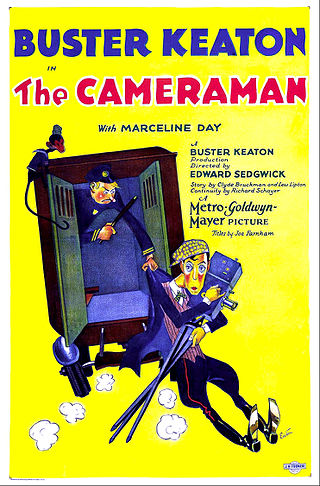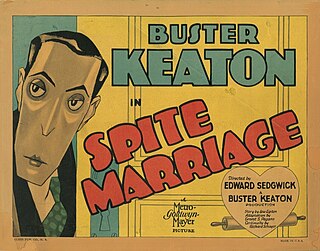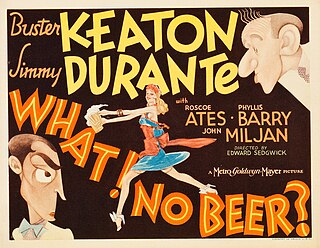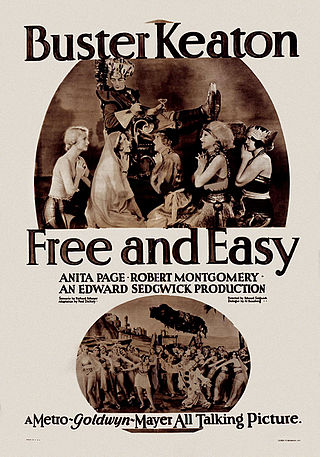Related Research Articles

Sherlock Jr. is a 1924 American silent comedy film starring and directed by Buster Keaton and written by Clyde Bruckman, Jean Havez, and Joseph A. Mitchell. It features Kathryn McGuire, Joe Keaton, and Ward Crane.

Edward Santree Brophy was an American character actor and comedian, as well as an assistant director and second unit director during the 1920s. Small of build, balding, and raucous-voiced, he frequently portrayed dumb cops and gangsters, both serious and comic.

The Cameraman is a 1928 American silent romantic comedy film directed by Edward Sedgwick and an uncredited Buster Keaton. The picture stars Keaton and Marceline Day.

Good Night, Nurse! is a 1918 American two-reel silent comedy film written by, and directed by, and starring Roscoe "Fatty" Arbuckle and featuring Buster Keaton. Roscoe's character's wife reaches the last straw with his drinking and admits him to the No Hope Sanatorium, which promises to cure all cases of alcoholism.

Spite Marriage is a 1929 American silent comedy film co-directed by Buster Keaton and Edward Sedgwick and starring Keaton and Dorothy Sebastian. It is the second film Keaton made for MGM and his last silent film, although he had wanted it to be a "talkie" or full sound film. While the production has no recorded dialogue, it does feature an accompanying synchronized score and recorded laughter, applause and other sound effects in some scenes. Keaton later wrote gags for some up-and-coming MGM stars like Red Skelton, and from this film recycled many gags, some shot-for-shot, for Skelton's 1943 film I Dood It.

Coney Island is a 1917 American two-reel silent comedy film starring, written and directed by Roscoe "Fatty" Arbuckle and featuring Buster Keaton.
The Gold Ghost is a 1934 short American pre-code comedy film starring Buster Keaton.
Hayseed Romance is a 1935 American short comedy film featuring Buster Keaton.
Tars and Stripes is a 1935 American Educational Pictures short comedy film directed by and starring Buster Keaton. The film was shot at the Naval Training Center San Diego, California.
The E-Flat Man is a 1935 American short comedy film featuring Buster Keaton.

The Timid Young Man is a 1935 American short comedy film directed by Mack Sennett and starring Buster Keaton.
Grand Slam Opera is a 1936 American short comedy film starring Buster Keaton and produced by Educational Pictures.

What! No Beer? is a 1933 Pre-Code comedy film released by Metro-Goldwyn-Mayer directed by Edward Sedgwick and starring Buster Keaton and Jimmy Durante. MGM had also paired Keaton and Durante as a comedy team during this period in The Passionate Plumber and Speak Easily.

Richard Michael Wessel was an American film actor who appeared in more than 270 films between 1935 and 1966. He is best remembered for his only leading role, a chilling portrayal of strangler Harry "Cueball" Lake in Dick Tracy vs. Cueball (1946), and for his appearances as comic villains opposite The Three Stooges.

Block Busters is a 1944 American comedy film directed by Wallace Fox and starring the East Side Kids.

The Buster Keaton Story is a 1957 American biographical drama film directed by Sidney Sheldon and written by Sidney Sheldon and Robert Smith, following the life of Buster Keaton. The film stars Donald O'Connor, Ann Blyth, Rhonda Fleming, Peter Lorre, Larry Keating and Jackie Coogan. It was released on April 21, 1957, by Paramount Pictures. The film was described by AllMovie as "sublimely inaccurate" regarding details of Keaton's life. It was produced by Paramount Pictures, which paid Keaton $50,000 for the rights to his life story.

Doughboys is a 1930 American Pre-Code comedy film starring Buster Keaton. It was Keaton's second starring talkie vehicle and has been called Keaton's "most successful sound Picture." A Spanish-language version was also made under the title, De Frente, Marchen.

Free and Easy is a 1930 American pre-Code comedy film starring Buster Keaton. It was Keaton's first leading role in a talking motion picture.

Hit and Run is a 1924 silent American comedy drama film directed by Edward Sedgwick and starring western star Hoot Gibson as a member of a baseball team. It was produced and distributed by Universal Pictures.

Warren Reynolds "Ray" Walker was an American actor, born in Newark, New Jersey, who starred in Baby Take a Bow (1934), Hideaway Girl (1936), The Dark Hour (1936), The Unknown Guest (1943) and It's A Wonderful Life (1946).
References
- ↑ "Buster Keaton - One Run Elmer (1935)". YouTube. Archived from the original on December 12, 2021. Retrieved June 26, 2020.